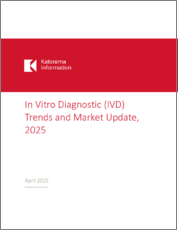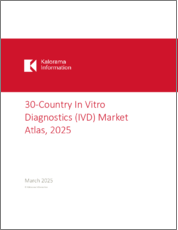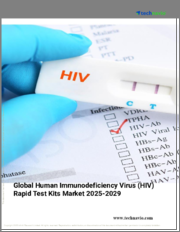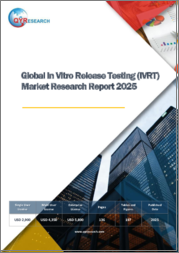
|
시장보고서
상품코드
1560785
세계의 체외진단(IVD) 시장(2024-2031년)Global In-Vitro Diagnostics Market - 2024 - 2031 |
||||||
리포트 개요
세계의 체외진단(IVD) 시장은 2023년 983억 달러에서 2031년에는 1,457억 달러에 달하며, 예측 기간인 2024-2031년 CAGR로 5.3%의 성장이 예측됩니다.
체외진단(IVD)은 인체 샘플을 사용하여 질병, 상태, 감염을 검출하기 위한 검사 분야입니다. 이러한 검사는 체외에서 보통 실험실에서 첨단 장비와 시약을 사용하여 수행됩니다. 체외진단(IVD) 의약품은 현대 의학에서 매우 중요하며, 질병 진단, 치료 방침 결정, 환자 건강 상태 모니터링에 중요한 정보를 제공하며, IVD 시장은 기술 발전, 세계 인구의 고령화, 만성질환, 맞춤형 의료에 대한 수요로 인해 빠르게 성장하고 있습니다.
시장 역학 :
촉진요인과 억제요인
기술 발전 증가
기술 발전 증가는 예측 기간 중 시장 성장을 가속할 것이며, PCR 및 NGS를 포함한 분자진단은 유전성 질환의 조기 발견을 가능하게 하여 진단 정확도와 치료 결과를 향상시킬 것입니다. 현장 검사 장비는 원격지에서 신속한 진단 및 치료를 가능하게 하며, IVD 시스템의 자동화 및 디지털화는 효율성을 높이고 인적 오류를 줄이며, 특히 원격지에서 더 정확한 결과를 제공합니다.
새롭고 정밀한 임상 실험실 검사의 도입은 전 세계에서 새로운 IVD 검사의 채택을 촉진하고 있습니다. 예를 들어 도레이는 2023년 6월 일본 후생노동성으로부터 췌장암 진단에 사용되는 도레이 APOA2-iTQ의 제조판매 허가를 취득했습니다.
또한 2023년 3월 애보트는 미국에서 새로운 실험실용 외상성 뇌손상(TBI) 혈액 검사에 대한 FDA 승인을 획득했습니다. 생명을 위협하는 질병에 대한 체외진단(IVD) 검사의 승인 증가는 미개척 시장에서 새로운 비즈니스 기회를 창출할 것으로 기대됩니다.
숙련된 전문 인력 부족
세계 체외진단(IVD) 시장은 엄격한 규제 요건, 고가의 첨단 진단 기술 비용, 숙련된 전문가 부족 등 여러 가지 도전 과제에 직면해 있습니다. 이러한 요인들은 새로운 진단 제품의 진입을 지연시키고 의료 예산이 제한된 개발도상국에서의 채택을 제한할 수 있습니다. 전반적으로 이러한 요인들은 IVD 시장 진출기업에게 큰 도전이 되고 있습니다.
시장 부문 분석
체외진단(IVD) 세계 시장은 제품 유형, 기술, 용도, 최종사용자, 지역별로 구분됩니다.
제품 유형별로는 시약이 체외진단(IVD) 시장 점유율의 약 41.3%를 차지하고 있습니다.
제품 유형별로는 시약이 약 41.3%를 차지합니다. 시약은 체외진단(IVD)에서 환자 검체내 생물학적 마커를 검출하고 정량화하는 데 필수적인 컴포넌트입니다. 시약은 표적 분석물과 반응하도록 설계되어 질병, 상태 및 감염을 식별하고 측정할 수 있도록 합니다. 시약은 진단 검사의 정확성과 신뢰성에 매우 중요하며 결과의 민감도와 특이성에 직접적인 영향을 미칩니다. 시약은 면역 분석, 분자진단, 임상 화학, 혈액학 등 다양한 진단 용도에 사용됩니다. 맞춤형 의료의 성장과 신속한 진단으로 인해 고품질 시약에 대한 수요가 증가하고 있습니다.
예를 들어 2023년 10월 미국의 화학제품 공급업체 알파케미컬(Alpha Chemistry)은 혈액, 조직 등의 샘플을 검사하여 검출된 질병을 조사할 수 있도록 생물학적 시약 제품군을 강화하여 실험실용 IVD 제품 3종을 발표했습니다.
지역별 시장 점유율
북미는 예측 기간 중 전체 시장 점유율의 약 38.4%를 차지할 것으로 예상됩니다.
북미는 만성질환 유병률 증가, 강력한 기업의 존재, 신규 검사 출시 증가, 정부 재정 지원 등으로 인해 예측 기간 중 전체 시장에서 약 38.4%의 점유율을 차지할 것으로 예상됩니다.
예를 들어 2023년 1월 BD와 CerTest Biotec은 미국에서 수두 바이러스 검출을 위한 PCR 검사에 대해 미국 FDA로부터 EUA를 획득했습니다. 또한 당뇨병 및 암과 같은 맞춤형 의료를 위한 유전자 검사에 대한 요구가 증가함에 따라 북미 시장 성장을 가속할 것으로 예상됩니다.
목차
제1장 조사 방법과 조사 범위
제2장 정의와 개요
제3장 개요
제4장 시장 역학
- 영향요인
- 촉진요인
- 기술의 진보
- 만성질환의 증가
- 억제요인
- 숙련 전문가의 부족
- 기회
- 영향 분석
- 촉진요인
제5장 산업 분석
- Porter's Five Forces 분석
- 공급망 분석
- 가격 분석
- 규제 분석
- 특허 분석
- PESTLE 분석
- SWOT 분석
- DMI 의견
제6장 제품 유형별
- 기기
- 시약
- 소프트웨어·서비스
제7장 기술별
- 면역분석법
- POC 진단
- 분자진단
- 혈액학
- 조직진단
- 미생물학
- 자기 혈당 모니터링
- 기타
제8장 용도별
- 감염증
- 당뇨병
- 암/종양
- 심장병
- 자가면역질환
- 신장병
- 약물 검사
- 기타
제9장 최종사용자별
- 진단 연구소
- 병원
- 학술·연구기관
- 기타
제10장 지역별
- 북미
- 미국
- 캐나다
- 멕시코
- 유럽
- 독일
- 영국
- 프랑스
- 이탈리아
- 스페인
- 기타 유럽
- 남미
- 브라질
- 아르헨티나
- 기타 남미
- 아시아태평양
- 중국
- 인도
- 일본
- 한국
- 기타 아시아태평양
- 중동 및 아프리카
제11장 경쟁 구도
- 경쟁 시나리오
- 시장 현황/점유율 분석
- M&A 분석
제12장 기업 개요
- BioMerieux
- 회사 개요
- 제품 포트폴리오와 설명
- 재무 개요
- 주요 발전
- Danaher Corporation
- Roche Diagnostics
- Becton, Dickinson and Company
- Bio-Rad Laboratories, Inc.
- Abbott Laboratories
- Bayer AG
- Arkray, Inc
- Sysmex Corporation
- Siemens AG
제13장 부록
KSA 24.10.11Report Overview
Global In Vitro Diagnostics Market reached US$ 98.3 billion in 2023 and is expected to reach US$ 145.7 billion by 2031, growing at a CAGR of 5.3% during the forecast period 2024-2031
In Vitro Diagnostics (IVD) is a field of tests used to detect diseases, conditions, or infections using human samples. These tests are conducted outside the body, typically in laboratory settings, using advanced instruments and reagents. IVD is crucial in modern medicine, providing critical information for disease diagnosis, treatment decisions, and monitoring patient health. The market for IVD is rapidly growing due to technological advancements, an aging global population, chronic diseases, and personalized medicine demand.
Market Dynamics: Drivers & Restraints
Rise in technological advancements
The rise in technological advancements help the market to grow during the forecast period. Molecular diagnostics, including PCR and NGS, enable early genetic disease detection, improving diagnosis accuracy and treatment outcomes. Point-of-care testing devices enable faster diagnosis and treatment in remote settings. Automation and digitalization in IVD systems improve efficiency, reduce human error, and provide more accurate results, especially in remote settings.
The introduction of novel and highly accurate clinical laboratory tests is boosting the adoption of novel IVD tests worldwide. For instance, in June 2023, Toray Industries, Inc. received marketing approval from Japan's Ministry of Health, Labour and Welfare for its Toray APOA2-iTQ used to diagnose pancreatic cancer.
Moreover, in March 2023, Abbott received U.S. FDA clearance for its novel laboratory Traumatic Brain Injury (TBI) blood test in the U.S. Increasing approvals of IVD tests for life-threatening diseases are expected to create new opportunities in the untapped market.
Lack of skilled professionals
The global in vitro diagnostics market faces several challenges, including stringent regulatory requirements, high costs of advanced diagnostic technologies, and a lack of skilled professionals. These factors can delay the entry of new diagnostic products and limit their adoption in developing countries with limited healthcare budgets. Overall, these factors pose significant challenges for companies operating in the IVD market.
Market Segment Analysis
The global in vitro diagnostics market is segmented based on product type, technique, application, end-user, and region.
The reagents from the product type segment accounted for approximately 41.3% of the in vitro diagnostics market share
The reagents from the product type segment accounted for approximately 41.3%. Reagents are essential components in in vitro diagnostics for detecting and quantifying biological markers in patient samples. They are designed to react with target analytes, enabling the identification and measurement of diseases, conditions, or infections. Reagents are crucial for the accuracy and reliability of diagnostic tests, directly affecting the sensitivity and specificity of results. They are used in various diagnostic applications, including immunoassays, molecular diagnostics, clinical chemistry, and hematology. The demand for high-quality reagents has increased due to personalized medicine growth and rapid diagnostics.
For instance, in October 2023, US-based chemical supplier Alfa Chemistry introduced three IVD products for laboratory use, enhancing its range of biological reagents, to aid in research on diseases detected through tests on samples like blood or tissue.
Market Geographical Share
North America is estimated to hold about 38.4% of the total market share throughout the forecast period
North America is estimated to hold about 38.4% of the total market share throughout the forecast period due rising incidence of chronic diseases, the presence of strong players, the increasing number of novel test launches, and supportive government funding.
For instance, in January 2023, BD and CerTest Biotec received EUA from the U.S. FDA for a PCR test for Mpox virus detection in the U.S. Moreover, the increasing requirement for genetic testing for personalized health care, such as that for diabetes and cancer, is expected to drive market growth in North America.
Market Segmentation
By-Product Type
Instruments
Reagents
Software and Services
By Technique
Immunoassays
POC diagnostics
Molecular diagnostics
Hematology
Tissue diagnostics
Microbiology
Self-Blood-Glucose Monitoring
Others
By Application
Infectious Diseases
Diabetes
Cancer/Oncology
Cardiology
Autoimmune Diseases
Nephrology
Drug Testing
Others
By End User
Diagnostic Laboratories
Hospitals
Academics and Research Institutes
Others
By Region
North America
The U.S.
Canada
Mexico
Europe
Germany
UK
France
Italy
Spain
Rest of Europe
South America
Brazil
Argentina
Rest of South America
Asia-Pacific
China
India
Japan
South Korea
Rest of Asia-Pacific
Middle East and Africa
Market Competitive Landscape
The major global players in the market include BioMerieux, Danaher Corporation, Roche Diagnostics, Becton, Dickinson and Company, Bio-Rad Laboratories, Inc., Abbott Laboratories, Bayer AG, Arkray, Inc., Sysmex Corporation, Siemens AG among others.
Key Developments
In January 2024, ELITech Group proudly announces the introduction of the GI Bacterial PLUS ELITe MGB Kit, a robust addition to its diagnostic portfolio. Tailored specifically for diagnosing gastrointestinal bacterial infections, the in vitro assay exclusively targets major bacterial pathogens including Campylobacter spp.
In September 2023, NeoDx Biotech Labs, a Bengaluru-based startup launched a Real-time PCR-Technology-based in vitro diagnostic (IVD) kit for Ankylosing Spondylitis & empowered healthcare services to improve their testing capabilities.
Why Purchase the Report?
To visualize the global in vitro diagnostics market segmentation based on product type, technique, application, end-user, and region as well as understand key commercial assets and players.
Identify commercial opportunities by analyzing trends and co-development.
Excel data sheet with numerous data points of the in vitro diagnostics market level with all segments.
PDF report consists of a comprehensive analysis after exhaustive qualitative interviews and an in-depth study.
Product mapping available as excel consisting of key products of all the major players.
The global in vitro diagnostics market report would provide approximately 64 tables, 61 figures, and 186 pages.
Target Audience 2024
Manufacturers/ Buyers
Industry Investors/Investment Bankers
Research Professionals
Emerging Companies
Table of Contents
1. Methodology and Scope
- 1.1. Research Methodology
- 1.2. Research Objective and Scope of the Report
2. Definition and Overview
3. Executive Summary
- 3.1. Snippet by Product Type
- 3.2. Snippet by Technique
- 3.3. Snippet by Application
- 3.4. Snippet by End User
- 3.5. Snippet by Region
4. Dynamics
- 4.1. Impacting Factors
- 4.1.1. Drivers
- 4.1.1.1. Rise in technological advancements
- 4.1.1.2. Rise in the prevalence of chronic diseases
- 4.1.2. Restraints
- 4.1.2.1. Lack of skilled professionals
- 4.1.3. Opportunity
- 4.1.4. Impact Analysis
- 4.1.1. Drivers
5. Industry Analysis
- 5.1. Porter's Five Force Analysis
- 5.2. Supply Chain Analysis
- 5.3. Pricing Analysis
- 5.4. Regulatory Analysis
- 5.5. Patent Analysis
- 5.6. PESTLE Analysis
- 5.7. SWOT Analysis
- 5.8. DMI Opinion
6. By Product Type
- 6.1. Introduction
- 6.1.1. Market Size Analysis and Y-o-Y Growth Analysis (%), By Product Type
- 6.1.2. Market Attractiveness Index, By Product Type
- 6.2. Instruments*
- 6.2.1. Introduction
- 6.3. Reagents
- 6.4. Software and Services
7. By Technique
- 7.1. Introduction
- 7.1.1. Market Size Analysis and Y-o-Y Growth Analysis (%), By Technique
- 7.2. Market Attractiveness Index, By Technique
- 7.3. Immunoassays*
- 7.3.1. Introduction
- 7.3.2. Market Size Analysis and Y-o-Y Growth Analysis (%)
- 7.4. POC diagnostics
- 7.5. Molecular diagnostics
- 7.6. Hematology
- 7.7. Tissue diagnostics
- 7.8. Microbiology
- 7.9. Self-Blood-Glucose Monitoring
- 7.10. Others
8. By Application
- 8.1. Introduction
- 8.1.1. Market Size Analysis and Y-o-Y Growth Analysis (%), By Application
- 8.1.2. Market Attractiveness Index, By Application
- 8.2. Infectious Diseases*
- 8.2.1. Introduction
- 8.3. Diabetes
- 8.4. Cancer/Oncology
- 8.5. Cardiology
- 8.6. Autoimmune Diseases
- 8.7. Nephrology
- 8.8. Drug Testing
- 8.9. Others
9. By End User
- 9.1. Introduction
- 9.1.1. Market Size Analysis and Y-o-Y Growth Analysis (%), By End User
- 9.1.2. Market Attractiveness Index, By End User
- 9.2. Diagnostic Laboratories*
- 9.2.1. Introduction
- 9.2.2. Market Size Analysis and Y-o-Y Growth Analysis (%)
- 9.3. Hospitals
- 9.4. Academics and Research Institutes
- 9.5. Others
10. By Region
- 10.1. Introduction
- 10.1.1. Market Size Analysis and Y-o-Y Growth Analysis (%), By Region
- 10.1.2. Market Attractiveness Index, By Region
- 10.2. North America
- 10.2.1. Introduction
- 10.2.2. Key Region-Specific Dynamics
- 10.2.3. Market Size Analysis and Y-o-Y Growth Analysis (%), By Product Type
- 10.2.4. Market Size Analysis and Y-o-Y Growth Analysis (%), By Technique
- 10.2.5. Market Size Analysis and Y-o-Y Growth Analysis (%), By Application
- 10.2.6. Market Size Analysis and Y-o-Y Growth Analysis (%), By End User
- 10.2.7. Market Size Analysis and Y-o-Y Growth Analysis (%), By Country
- 10.2.7.1. The U.S.
- 10.2.7.2. Canada
- 10.2.7.3. Mexico
- 10.3. Europe
- 10.3.1. Introduction
- 10.3.2. Key Region-Specific Dynamics
- 10.3.3. Market Size Analysis and Y-o-Y Growth Analysis (%), By Product Type
- 10.3.4. Market Size Analysis and Y-o-Y Growth Analysis (%), By Technique
- 10.3.5. Market Size Analysis and Y-o-Y Growth Analysis (%), By Application
- 10.3.6. Market Size Analysis and Y-o-Y Growth Analysis (%), By End User
- 10.3.7. Market Size Analysis and Y-o-Y Growth Analysis (%), By Country
- 10.3.7.1. Germany
- 10.3.7.2. UK
- 10.3.7.3. France
- 10.3.7.4. Italy
- 10.3.7.5. Spain
- 10.3.7.6. Rest of Europe
- 10.4. South America
- 10.4.1. Introduction
- 10.4.2. Key Region-Specific Dynamics
- 10.4.3. Market Size Analysis and Y-o-Y Growth Analysis (%), By Product Type
- 10.4.4. Market Size Analysis and Y-o-Y Growth Analysis (%), By Technique
- 10.4.5. Market Size Analysis and Y-o-Y Growth Analysis (%), By Application
- 10.4.6. Market Size Analysis and Y-o-Y Growth Analysis (%), By End User
- 10.4.7. Market Size Analysis and Y-o-Y Growth Analysis (%), By Country
- 10.4.7.1. Brazil
- 10.4.7.2. Argentina
- 10.4.7.3. Rest of South America
- 10.5. Asia-Pacific
- 10.5.1. Introduction
- 10.5.2. Key Region-Specific Dynamics
- 10.5.3. Market Size Analysis and Y-o-Y Growth Analysis (%), By Product Type
- 10.5.4. Market Size Analysis and Y-o-Y Growth Analysis (%), By Technique
- 10.5.5. Market Size Analysis and Y-o-Y Growth Analysis (%), By Application
- 10.5.6. Market Size Analysis and Y-o-Y Growth Analysis (%), By End User
- 10.5.7. Market Size Analysis and Y-o-Y Growth Analysis (%), By Country
- 10.5.7.1. China
- 10.5.7.2. India
- 10.5.7.3. Japan
- 10.5.7.4. South Korea
- 10.5.7.5. Rest of Asia-Pacific
- 10.6. Middle East and Africa
- 10.6.1. Introduction
- 10.6.2. Key Region-Specific Dynamics
- 10.6.3. Market Size Analysis and Y-o-Y Growth Analysis (%), By Product Type
- 10.6.4. Market Size Analysis and Y-o-Y Growth Analysis (%), By Technique
- 10.6.5. Market Size Analysis and Y-o-Y Growth Analysis (%), By Application
- 10.7. Market Size Analysis and Y-o-Y Growth Analysis (%), By End User
11. Competitive Landscape
- 11.1. Competitive Scenario
- 11.2. Market Positioning/Share Analysis
- 11.3. Mergers and Acquisitions Analysis
12. Company Profiles
- 12.1. BioMerieux*
- 12.1.1. Company Overview
- 12.1.2. Product Portfolio and Description
- 12.1.3. Financial Overview
- 12.1.4. Key Developments
- 12.2. Danaher Corporation
- 12.3. Roche Diagnostics
- 12.4. Becton, Dickinson and Company
- 12.5. Bio-Rad Laboratories, Inc.
- 12.6. Abbott Laboratories
- 12.7. Bayer AG
- 12.8. Arkray, Inc
- 12.9. Sysmex Corporation
- 12.10. Siemens AG (*LIST NOT EXHAUSTIVE)
13. Appendix
- 13.1. About Us and Services
- 13.2. Contact Us



















